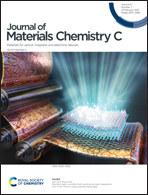Stable deep blue emission with unity quantum yield in organic–inorganic halide perovskite 2D nanosheets doped with cerium and terbium at high concentrations†
Abstract
Despite recent efforts, achieving stable deep blue emission with near unity quantum yield from lead-free perovskite has remained a great challenge. In this study, we have developed a novel strategy to achieve stable and deep blue emission with absolute unity photoluminescence (PL) quantum yield (QY) through Ce3+ and Tb3+ doping at high concentrations in 2D CH3NH3PbBr3 nanosheets (NSs) using a solvothermal method. We investigated the role of dopants in achieving the high QY and deep blue emission in a 2D perovskite using density functional theory (DFT) based calculations of its electronic structure. Our studies reveal that with Ce/Tb doping, the thickness of the NSs systematically goes down from 10 layers to bilayers (1.4 nm) at high doping levels and the bandgap of the 2D perovskite layer increases from 2.394 eV to 2.981 eV. The measured bandgap widening with doping is analyzed and explained on the basis of the quantum confinement effect and lattice contraction. Interestingly, by incorporating 70 mol% CeBr3 in the perovskite crystal, we achieved a deep blue emitting nanoplatelet with 100% QY, narrow linewidth (∼24 nm), and a color coordinate of (0.145, 0.054) closely matching with the standard color Rec. 2020 (0.131, 0.046) specification, making it one of the most efficient perovskite blue light emitters reported to date. We also demonstrate much improved storage stability of the Ce and Tb doped NS, fully consistent with the DFT calculations. The low temperature PL study reveals the coexistence of ordered and disordered orthorhombic phases. From DFT calculations, we show that the dopants stabilize the structure with lower formation energy and enrich the conduction band edge states without introducing deep trap states, which is responsible for the high PL QY. The calculation also reveals that Tb doping leads to a substantial increase in the bandgap, which is fully consistent with our experimental results. Finally, the Ce3+ doped CH3NH3PbBr3 blue-emitting nanoplatelet is used as a white light LED with CIE coordinates (0.334, 0.326). This work demonstrates a versatile approach to develop rare-earth doped deep blue-emitting 2D perovskites with exceptionally high PL QY and provides new insights into the structural stability and electronic structure of rare-earth doped 2D perovskites.

- This article is part of the themed collection: Showcasing recent research in materials chemistry from IIT Bombay, IIT Indore and IISc


 Please wait while we load your content...
Please wait while we load your content...